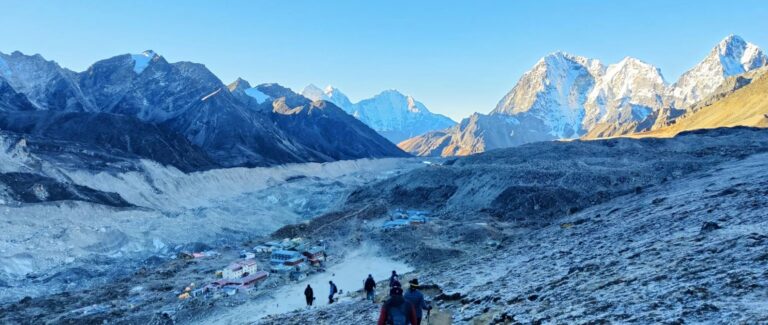Everest Base Camp Trek
Posted On:Sunday, May 5, 2024

The Everest Base Camp Trek is one of the most important trekking beats in the world, attracting gambol and nature lovers from all sides of the world. It takes everyone on a natural scamper as it provides a breathtaking sight of lush flora and fauna and snow-capped mountains. Climbing Mount Everest Base Camp is a step in the right in climbing.
Route:
The trek as a general rule starts and ends in Lukla, a town in the Khumbu region of Nepal. The trek, as a rule, starts and ends in Lukla, a percent in the Khumbu in the ballpark of Nepal. You can reach Lukla by a short flight from Kathmandu. This section, situated at 8,016 meters (26,289 feet) between Lhotse and Everest, is notorious for its treacherous weather conditions.
The trek makes one way through various. On some of the world’s giant and most well-liked mountains on the Everest Base Camp trek, trekkers also see snow slides, greenwood, lakes, the inland sea, and wild animals.
Duration:
The standard time for the Everest Base Camp trek is 12 to 14 days.
Wisely pack:
Pack lightweight but vitally important articles for the trek. Some vital items include a good pair of trekking boots, well-furnished clothing in layers, a warm sleeping bag, a down jacket, a waterproof jacket, gloves, a water bottle, and basic toiletries.
Currency:
Major currencies AUD, EUR, GBP, and USD are used to gain a visa. There are ATMs in Kathmandu and Pokhara, and credit cards are taken in bounded shops and many restaurants in Kathmandu and Pokhara. Outside the cities, credit and debit cards are unplayable to use to pay for the deficiency of card-reading machines. It is looking with favor on changing currency to Nepali rupees (Rs.) in Kathmandu or before, as it is accepted everywhere in Nepal.
Highlights:
From Everest base camp, we were given a bounty of spectacular views of Mt. Everest, Lhotse, Nuptse, and Pumori, as well as the imposing Khumbu glacier and icefalls and snow slipping beyond our eyes. It is the major highlight of the Everest Base Camp Trek.
The lofty point you’ll stretch out is Kala Patthar, at a step up of 5545m or 18,192 f. Familiarization days are set up in the daybook to help adventurers adjust to the high elevation and lessen the possibility of altitude ailment.
Permits:
The government of Nepal has made it essential for all adventurers to come with the essential entry grant, comprehend the Sagarmatha National Park permit and TIMS (Trekkers’ Information Management System) card. These grants are of the whopping great importance to ensure the safety and safeguarding of adventure, as well as to take awareness of the habitat and cultural heritage of the region.
Best time to visit:
The best time to visit Everest Base Camp is either side of the late May to mid-Sep monsoon season. Late September–November and February–May are the most important trekking months, with well-constructed conditions, good clarity, and temperatures at Base Camp rising to about -6°C.
These seasons don’t have the jumbo snow dung heap of winter, nor do they have the monsoonal rains of summer.
Physical Fitness:
While the trek doesn’t pertain to technical climbing or being pro-level athlete-shaped
A good level of physical fitness and staying power is necessary due to the stand against the countryside and altitude. Step by step, increase the duration and degree of your journey on foot to build your staying power over time.
Guided:
Consider taking on a guide and/or stretcher bearer for support and to enhance the overall experience. Many guided treks provide support, local expertise, and assistance with direction.
It is important to gain guided treks because Nepal’s government has implemented new regulations that require all trekkers to take on a licensed guide and porter for their journey. This change aims to increase the safety of adventure and ensure responsible tourism, as the guides are trained to pick up unforeseen circumstances and are well-versed in the local terrain and culture.
Conclusion:
The sight from Everest Base Camp Trek is not only a get-together for the eyes; it’s an encouragement for the soul. Yes, it is one of the many reasons to go on a trek to Everest Base Camp. You’re standing in a frame of mind that very few have the benefit of experiencing.
For some, a base camp is a form of underworld, a temporary port where one must spend four or five weeks giving and taking for the chance to climb Everest. For others, it’s the concluding summer camp, a place and community far apart from any other on Earth. Either way, for those who want to move up to the highest point on the planet, these are the two starting points.


